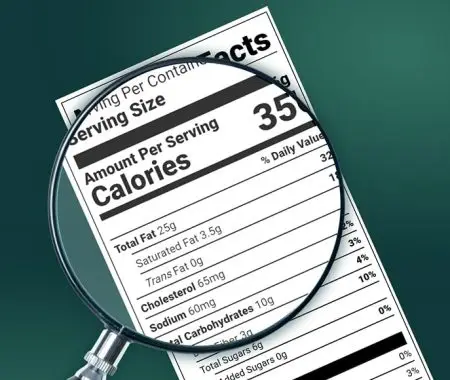In recent years, consumers have placed more importance on the nutrients found in the food they eat and its relationship with their health. Nutrient density displays the amount of beneficial nutrients a food has in proportion to its energy content, and when displayed on nutrition labels, can be crucial for these health-conscious consumers to make informed food choices. In Canada, the Canadian Food Inspection Agency (CFIA) has set strict regulations regarding food label claims in response to this, so that any statements about nutrient density are both accurate and verifiable for a customer who wants to make a worthwhile decision when it comes to the food they choose to consume. This guide will delve into the significance of nutrient density in food labeling and how these regulations influence consumer marketing and broader public health.
What is Nutrient Density?
Nutrient density is defined as the quantity of essential nutrients a food provides per unit of energy or calories. Foods high in nutrient density are rich in essential elements like vitamins, minerals, fiber, and other beneficial substances while having relatively few calories. The concept of nutrient density is being used more in how businesses market their products, as they can highlight that their product has a superior nutritional profile and if it meets the relevant criteria set out by the CFIA. Declaring that your food product is nutrient-dense can influence consumers to choose foods that offer more nutritional benefits and are beneficial for their health in the long run.
CFIA Regulations on Nutrient Density Claims
The CFIA has established specific guidelines governing the use of nutrient density claims on food packaging. These regulations have been put in place to ensure that, much like other health claims, a nutrient-density claim is backed up by science and not misleading to a consumer.
To make a nutrient density claim, a product must meet the following criteria:
- Nutrient Thresholds: The product must contain a significant amount of one or more “beneficial nutrients” relative to its caloric content. Vitamins, minerals, protein, or dietary fiber are most commonly categorized as “beneficial nutrients”.
- Caloric Content: The claim must reflect a favorable ratio of nutrients to calories. This means that the food should provide a high level of nutrients while being relatively low in calories.
- Scientific Substantiation: Any claim about nutrient density must be based on recognized scientific evidence that the nutrient levels claimed are indeed beneficial to health.
- Consistency with Dietary Guidelines: Claims should align with the overall dietary recommendations and guidelines provided by Health Canada, ensuring that they promote a balanced and healthful diet.
These regulations help protect consumers by preventing misleading claims on food labels and supporting informed and health-conscious decisions in the marketplace. By adhering to these guidelines, manufacturers contribute to a trustworthy food labeling system that values accuracy and consumer health.
See How FoodLabelMaker Can Help You
Calculating and Substantiating Nutrient Density
Calculating nutrient density involves assessing the amount of beneficial nutrients a food provides relative to its energy (caloric) content. To calculate accurate nutrient values according to CFIA guidelines, food manufacturers should:
- Identify Your Goal
When developing accurate nutrient values for foods, the first thing to decide is how you plan to use this nutritional information. Whether it’s for a research project, updating a database like the Canadian Nutrient File, reformulating a product to meet health standards, or creating a Nutrition Facts table for packaging, your goal will guide what data you need to gather.
- Measure Nutrient Quantities
Accurately measure the amounts of these nutrients per serving. This can be done using a Direct Approach or an Indirect Approach:
- Direct: Measures the actual nutrient content of the food product via lab analysis. It’s used when precise, product-specific nutrient information is needed, especially for food labeling and when new products are developed.
- Indirect: Uses existing nutrient data from standard food composition tables to estimate the nutrient density. Suitable for more general nutritional assessments and when the cost or feasibility of direct lab testing is prohibitive.
There are advantages and disadvantages to both, those being the costs involved with laboratory testing, the time you have available, and whether there is nutrition information regarding your product already.
In practical terms, for most businesses, especially those starting with new products or needing to meet specific regulatory requirements for labeling, a combination of both might be necessary. Initial product development might use indirect methods for formulation purposes, while final product testing might require direct methods to ensure compliance with labeling standards. In both cases, your values need to be as accurate as possible not only to avoid any CFIA penalties but to protect the consumer with truthful and reliable information.
- Assess Your Findings
Gather the data you have collected in your tests, analyses, and research methods. This is also an opportunity for you to check whether the values are accurate and lets you rule out any outliers or errors that occurred. Calculate the nutrient values from this collected data and assessment.
- Transparent Documentation
Ensure that you have detailed records of all the scientific processes, research that was reviewed, and personnel involved. This also ensures that you can repeat the process for other food products that need nutrient values.
For more detailed guidance on calculating nutrient density and understanding the methods suitable for your needs, consulting with a food scientist or a professional nutritionist is advisable. They can provide expertise in the appropriate use of these methods depending on your specific requirements and regulatory context.
Examples of Effective Nutrient Density Claims
Effective nutrient density claims not only align with CFIA standards but also resonate well with consumers and could boost product sales. Examples include:
- “High in Fiber and Low in Calories”: This claim can be effective on products like whole-grain breads or cereals, where the fiber content is substantial relative to the calorie count.
- “Rich in Vitamins A and C, with Few Calories”: Ideal for fruits and vegetables, such claims make these products attractive to those looking to enhance nutrient intake without significant caloric addition.
These claims work because they clearly communicate the health benefits in a way that is directly applicable to consumers’ dietary goals, such as weight management or improved nutrient intake.
Navigating Compliance with FoodLabelMaker
Food Label Maker is a platform that creates food labels that are compliant with CFIA regulations and provide customers with accurate and appealing nutrition information. Some of their key features include:
- Compliance Checks: Automated tools review labels against current CFIA regulations to ensure all nutrient density claims are accurately represented and substantiated.
- Nutrient Analysis Tools: These tools help calculate the nutrient density of products by analyzing nutrient content relative to caloric intake, simplifying the process of claim substantiation.
- Customizable Label Templates: Tailored templates that accommodate nutrient density claims, ensuring that all required information is presented clearly and in compliance with regulatory standards.
Other than these main features, Food Label Maker also has a team of expert nutritionists who can guide you through the complexities of nutrition density claims or answer any questions you may have about nutrition labels. Support from a platform like Food Label Maker is essential not only for regulatory compliance but can also help you build and maintain consumer trust in the competitive Canadian food market.
Conclusion
Nutrient density claims are vital for consumers who are more conscious about their health. The CFIA states that these claims, like all nutrition claims on food labels in Canada, need to be accurate and supported by scientific evidence. Effective nutrient density claims also help differentiate products in a crowded market by highlighting their superior nutritional value per calorie, which is a significant advantage for all consumers in the market.
To aid in achieving compliance and maximizing the marketability of food products, utilizing a tool like Food Label Maker is also recommended. Their nutrition experts can assist you with claims, and their platform has customizable and selective features to help you create CFIA-compliant food labels. Their platform ensures that nutrient density claims and other nutritional information on your product are accurate and meet all necesary regulations.
FAQs
What are nutrition claims on food labels Canada?
Nutrition claims on Canadian food labels include any statement that suggests a food has particular nutritional properties. These can be nutrient content claims, which describe the level of a nutrient in a product (like “low fat” or “high in vitamin C”), or health claims, which relate the consumption of food to health benefits or reduced risk of disease.
Is a nutrient content claim required on a food label?
A nutrient content claim is not required on a food label but can be included if the food meets specific criteria set by Health Canada and the CFIA. These claims are regulated to ensure that they are truthful and help consumers make informed dietary choices. Including such claims can enhance the appeal of products to consumers looking for specific health benefits or dietary needs.



